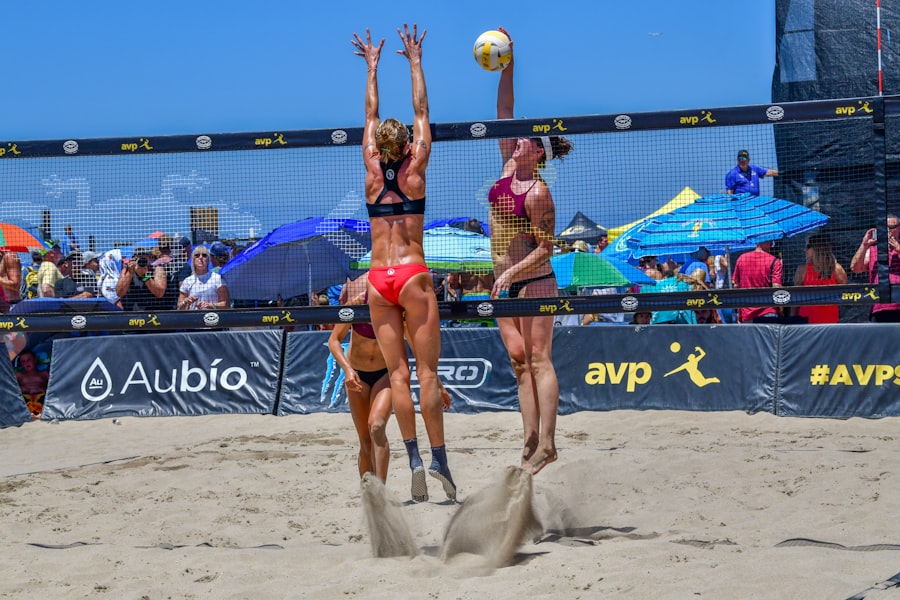Download links
How to install Mastering Volleyball: Tips for Improving Your Game APK?
1. Tap the downloaded Mastering Volleyball: Tips for Improving Your Game APK file.
2. Touch install.
3. Follow the steps on the screen.
Description
Volleyball is a dynamic and fast-paced sport that has captivated millions around the globe. Originating in the United States in 1895, it has evolved into a highly competitive game played both indoors and on the beach. The fundamental objective of volleyball is simple: two teams, typically consisting of six players each, aim to score points by sending a ball over a net and into the opposing team’s court.
The game is played in sets, with teams needing to reach a predetermined number of points, usually 25, to win a set. Matches are often played in a best-of-five format, adding to the excitement and intensity of the competition. The court dimensions and equipment are standardized, with a net height of approximately 2.43 meters for men’s volleyball and 2.24 meters for women’s volleyball.
The ball itself is lightweight and designed for optimal playability, allowing for powerful serves and precise passes. Each team is allowed three touches to return the ball over the net, which encourages strategic play and teamwork. Understanding these basic rules and the structure of the game is essential for anyone looking to engage in volleyball, whether casually or competitively.
Key Takeaways
- Volleyball is a team sport played with six players on each side, aiming to score points by grounding the ball on the opponent’s court.
- Essential skills in volleyball include serving, passing, and hitting, which require precision, timing, and coordination.
- Defensive techniques such as digging and blocking are crucial for preventing the opponent’s attacks and maintaining control of the game.
- Effective communication and teamwork are essential for success on the volleyball court, requiring players to support and coordinate with each other.
- Physical fitness and agility are key components of volleyball, as players need to be quick, agile, and have good endurance to perform well in the game.
Developing Essential Skills: Serving, Passing, and Hitting
The foundation of any successful volleyball player lies in mastering essential skills such as serving, passing, and hitting. Serving is the first opportunity a player has to impact the game, and it can set the tone for the entire rally. There are various types of serves, including the underhand serve, overhand serve, and jump serve.
Each type requires different techniques and levels of power. For instance, a jump serve involves a player jumping while striking the ball, generating significant speed and spin that can challenge opponents’ reception. Passing, often referred to as “forearm passing” or “bumping,” is crucial for maintaining possession of the ball.
A well-executed pass allows the setter to deliver an accurate set to the hitter. Players must develop proper body positioning and footwork to ensure they can react quickly to incoming serves or attacks from opponents. The ability to read the trajectory of the ball and anticipate its landing spot is vital for effective passing.
Practicing drills that focus on these skills can significantly enhance a player’s overall performance on the court. Hitting, or attacking, is where players can showcase their power and precision. A successful hit requires not only strength but also timing and technique.
Players must learn to approach the net with speed, jump at the right moment, and make contact with the ball at its highest point. Different types of hits, such as spikes or tips, can be employed depending on the situation. For example, a spike is typically used when a player has a clear opportunity to score, while a tip may be more effective when facing a well-formed block from the opposing team.
Mastering Defensive Techniques: Digging and Blocking

Defensive skills are just as critical as offensive ones in volleyball. Two key defensive techniques are digging and blocking. Digging involves receiving an attack from an opponent, often requiring quick reflexes and agility.
A successful dig can turn the tide of a rally by keeping the ball in play and allowing teammates to regroup for a counterattack. Players must be adept at reading their opponents’ movements to anticipate where the ball will go. Practicing digging drills that simulate various attack angles can help players improve their reaction times and overall defensive capabilities. Blocking is another essential defensive skill that involves intercepting an opponent’s attack at the net. A well-timed block can not only prevent a point from being scored but can also energize a team and shift momentum in their favor.
Effective blocking requires coordination between teammates, as well as an understanding of the opposing hitters’ tendencies.
Training sessions that focus on footwork, timing, and communication among blockers can significantly enhance a team’s defensive strength.
Improving Communication and Teamwork on the Court
| Metrics | Current | Target |
|---|---|---|
| Number of successful passes per game | 20 | 30 |
| Percentage of successful set plays executed | 70% | 85% |
| Number of communication breakdowns per game | 5 | 2 |
| Teamwork rating (out of 10) | 7 | 9 |
In volleyball, communication is paramount for success. The fast-paced nature of the game necessitates that players constantly communicate with one another to coordinate plays effectively. This includes calling for the ball, signaling plays, and providing feedback during rallies.
Establishing clear communication protocols within a team can help reduce confusion and ensure that everyone is on the same page during critical moments. Teamwork goes hand-in-hand with communication. Volleyball is inherently a team sport; individual brilliance can only take a team so far without cohesive collaboration.
Players must learn to trust one another and work together towards common goals. This involves understanding each other’s strengths and weaknesses, as well as developing strategies that capitalize on those attributes. Regular team-building exercises off the court can foster camaraderie and improve overall team dynamics, leading to better performance during matches.
Enhancing Physical Fitness and Agility for Volleyball
Physical fitness plays a crucial role in volleyball performance.
Players must be able to sprint across the court, jump high for blocks or spikes, and maintain their energy levels throughout long matches.
Incorporating strength training into a player’s routine can enhance muscle power, which is essential for explosive movements like jumping and hitting. Agility training is equally important in volleyball. Quick lateral movements are often required to position oneself effectively for passing or digging.
Drills that focus on footwork, such as ladder drills or cone drills, can help improve agility and reaction times. Additionally, cardiovascular conditioning is vital for maintaining stamina during matches; incorporating activities like running or cycling into training regimens can help players build endurance.
Learning Advanced Strategies for Game Play

As players become more experienced in volleyball, they should begin to explore advanced strategies that can give them an edge over their opponents. One such strategy is understanding how to read defenses effectively. This involves analyzing opponents’ formations and identifying weaknesses that can be exploited during play.
For instance, if a team consistently leaves an area of their court open during serves or attacks, players can adjust their hitting strategies accordingly. Another advanced strategy involves utilizing different offensive formations such as 5-1 or 6-2 systems. In a 5-1 system, one setter remains on the court at all times, while in a 6-2 system, two setters rotate in and out of play.
Each formation has its advantages depending on the team’s strengths and playing style. Understanding when to implement these strategies can significantly impact a team’s performance during matches.
Mental Preparation and Focus for Competitive Matches
Mental preparation is often overlooked in sports training but is crucial for achieving peak performance in volleyball. Players must cultivate focus and concentration to perform well under pressure during competitive matches. Techniques such as visualization can be beneficial; players can mentally rehearse their plays or visualize themselves succeeding in specific situations on the court.
Additionally, developing resilience is essential for handling setbacks during matches. Volleyball is inherently unpredictable; teams may face unexpected challenges such as injuries or sudden shifts in momentum. Players who can maintain composure and adapt their strategies in response to these challenges are more likely to succeed in high-stakes situations.
Engaging in mindfulness practices or relaxation techniques can help players manage stress and maintain focus throughout intense matches.
Seeking Professional Coaching and Training Opportunities
For those serious about improving their volleyball skills, seeking professional coaching can be invaluable. Experienced coaches provide personalized feedback and tailored training programs that address individual strengths and weaknesses. They can also introduce players to advanced techniques and strategies that may not be readily available through self-directed practice.
In addition to coaching, participating in training camps or clinics can offer players exposure to different styles of play and coaching philosophies. These opportunities allow athletes to learn from various experts in the field while also networking with other players who share similar goals. Engaging in competitive leagues or tournaments can further enhance skills through real-game experience against diverse opponents.
By investing time in professional coaching and training opportunities, players can accelerate their development in volleyball while gaining insights that will serve them throughout their athletic careers.
FAQs
What is volleyball?
Volleyball is a team sport in which two teams of six players each are separated by a net. The objective is to score points by grounding the ball on the opposing team’s court.
What are the basic rules of volleyball?
The basic rules of volleyball include serving the ball over the net, rallying to keep the ball in play, and trying to score points by grounding the ball on the opposing team’s court. Each team is allowed three touches to return the ball.
What are the different types of volleyball games?
There are several different types of volleyball games, including indoor volleyball, beach volleyball, and sitting volleyball. Each type has its own specific rules and variations.
What equipment is needed to play volleyball?
The main equipment needed to play volleyball includes a volleyball, a net, and appropriate footwear. Players also typically wear knee pads and may use other protective gear.
What are the health benefits of playing volleyball?
Playing volleyball can provide a range of health benefits, including improved cardiovascular fitness, increased strength and agility, and enhanced hand-eye coordination. It also promotes teamwork and social interaction.
What are the key skills needed to play volleyball?
Key skills needed to play volleyball include serving, passing, setting, attacking, and blocking. Players also need good communication and teamwork skills to be successful in the sport.





